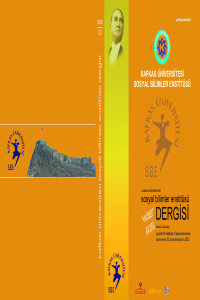Abstract
Akıllı tekstiller son yıllarda kullanıma giderek artan ve gündelik hayatta karşımıza sıkça çıkmaya başlayan özel tekstil ürünleridir. Akıllı tekstiller içerisinde elektronik, bilgisayar bileşenleri, akıllı kimyasallar ve tekstil ürünlerini birlikte barındırabilmektedir. Kromik boyarmaddeler, akıllı tekstiller içerisinde yer alan ve çeşitli ortam koşullarında tersinir renk değiştirebilme özelliğine sahip olan materyallerdir. Kromik boyarmaddeler etkilendiği dış ortam koşuluna göre (ışık, pH, su, sıcaklık vd.) renk değiştirmektedir. Kromik boyarmaddeler içerisinde sıcaklık değişimine göre renk değiştirebilen ürünler termokromik boyarmaddeler olarak sınıflandırılmaktadır. Bu çalışmada, akıllı tekstiller, kromik materyaller ve termokromik tekstillerin ne olduğu açıklanmakta ve termokromik boyarmadde kullanılarak yapılabilecek örnek bir tekstil baskı tasarımı uygulaması aşamalarıyla beraber gösterilmektedir. Çalışma sonucunda termokromik boyarmaddeler hakkında tekstil sektöründe çalışan kişilerin daha çok bilgi sahibi olması hedeflenmekte ve termokromik gibi özel materyallerin kullanılarak katma değeri çok daha yüksek spesifik ürünlerin tekstil tasarımında üretilebileceği gösterilmektedir.
Keywords
References
- Aitken, D., Burkinshaw, S. M., Griffiths, J. & Towns, A. D. (1996). Rev. prog. Coloration, 26, 1.
- Antonov L. (2014). Tautomerism: Methods and theories.Weinheim: Wiley-VCH Verlag GmbH & Co..
- Bamfield, P. (2001). Chromic phenomena: technological applications of colour chemistry, Cambridge: RSC Publishing.
- Behera, A. (2022). Advanced materials. USA: Springer Nature Switzerland AG.
- Berzowska, J. (2015). Electronic textiles: wearable computers, reactive fashion, and soft computation. Textile The Journal of Cloth and Culture, 3(1), 58-74.
- Billah, S. M. R., Christie, R. M., & Shamey, R. (2008). Direct Coloration Of Textiles With Photochromic Dyes. Part 1: Application Of Spiroindolinonaphthoxazines As Disperse Dyes To Polyester, Nylon And Acrylic Fabrics. Coloration Technology, 124 (4), 223–228.
- Billah, S.M.R. (2014). Smart textiles and the effective uses of photochromic, thermochromic, ionochromic and electrochromic molecular switches. Mondal, İ.H. (Editör) Textiles history, properties and performance and applications içinde. USA: Nova.
- Bing(2023).Fiber2fashion. 18 Şubat 2023 tarihinde https://static.fibre2fashion.com/ ArticleResources/Images/69/6862/smart-and-interactive-big.jpg–Bing adresinden erişildi.
- Cai, G., Yang, M., Pan, J., Cheng, D., Xia, Z., Wang, X. & Tang, B. (2018). Large-scale production of highly stretchable cnt/cotton/spandex composite yarn for wearable applications. ACS Appl. Mater. Interfaces, 10 (2018), 32726–32735.
- Chen, H. J. & Huang, L, H. (2015). An investigation of the design potential of thermochromic home textiles used with electric heating techniques. Hindawi Publishing Corporation Mathematical Problems in Engineering, (2015), 1-5.
- Chika, Y-B. & Adekunle, S.A. (2017). Smart fabrics-wearable technology. International Journal Of Engineering Technologies And Management Research, 4(10), 78-98.
- Chowdhury, M. A., Joshi, M. & Butola, B. S. (2014). Photochromic and thermochromic colorants in textile applications. Journal Of Engineered Fibers And Fabrics, 9(1), 107-123.
- Corder, R. (2016). Connected smart technology set to be sewn into clothing for the elderly. care home professional. 26 Şubat 2023 tarihinde https://www.carehomeprofessional.com/connected-smart-technology-set-to-be-sewn-into-clothing-for-the-elderly-2/ adresinden erişildi.
Abstract
Smart textiles are special textile products that have been increasingly used in recent years and have started to appear frequently in daily life. Smart textiles can contain electronics, computer components, smart chemicals and textile products together. Chromic dyestuffs are materials that are included in smart textiles and have the ability to change color reversibly under various environmental conditions. Chromic dyestuffs can be applied according to the outdoor conditions (light, pH, water, temperature, etc.). Among the chromic dyestuffs, the products that can change color according to the temperature change are classified as thermochromic dyestuffs. In this study, smart textiles, chromic materials and thermochromic textiles are explained and a sample textile printing design application that can be made using thermochromic dyestuffs is shown together with the stages. As a result of the study, it is aimed that people working in the textile industry have more information about thermochromic dyestuffs and it is shown that specific products with much higher added value can be produced in textile design by using special materials such as thermochromic.
Keywords
References
- Aitken, D., Burkinshaw, S. M., Griffiths, J. & Towns, A. D. (1996). Rev. prog. Coloration, 26, 1.
- Antonov L. (2014). Tautomerism: Methods and theories.Weinheim: Wiley-VCH Verlag GmbH & Co..
- Bamfield, P. (2001). Chromic phenomena: technological applications of colour chemistry, Cambridge: RSC Publishing.
- Behera, A. (2022). Advanced materials. USA: Springer Nature Switzerland AG.
- Berzowska, J. (2015). Electronic textiles: wearable computers, reactive fashion, and soft computation. Textile The Journal of Cloth and Culture, 3(1), 58-74.
- Billah, S. M. R., Christie, R. M., & Shamey, R. (2008). Direct Coloration Of Textiles With Photochromic Dyes. Part 1: Application Of Spiroindolinonaphthoxazines As Disperse Dyes To Polyester, Nylon And Acrylic Fabrics. Coloration Technology, 124 (4), 223–228.
- Billah, S.M.R. (2014). Smart textiles and the effective uses of photochromic, thermochromic, ionochromic and electrochromic molecular switches. Mondal, İ.H. (Editör) Textiles history, properties and performance and applications içinde. USA: Nova.
- Bing(2023).Fiber2fashion. 18 Şubat 2023 tarihinde https://static.fibre2fashion.com/ ArticleResources/Images/69/6862/smart-and-interactive-big.jpg–Bing adresinden erişildi.
- Cai, G., Yang, M., Pan, J., Cheng, D., Xia, Z., Wang, X. & Tang, B. (2018). Large-scale production of highly stretchable cnt/cotton/spandex composite yarn for wearable applications. ACS Appl. Mater. Interfaces, 10 (2018), 32726–32735.
- Chen, H. J. & Huang, L, H. (2015). An investigation of the design potential of thermochromic home textiles used with electric heating techniques. Hindawi Publishing Corporation Mathematical Problems in Engineering, (2015), 1-5.
- Chika, Y-B. & Adekunle, S.A. (2017). Smart fabrics-wearable technology. International Journal Of Engineering Technologies And Management Research, 4(10), 78-98.
- Chowdhury, M. A., Joshi, M. & Butola, B. S. (2014). Photochromic and thermochromic colorants in textile applications. Journal Of Engineered Fibers And Fabrics, 9(1), 107-123.
- Corder, R. (2016). Connected smart technology set to be sewn into clothing for the elderly. care home professional. 26 Şubat 2023 tarihinde https://www.carehomeprofessional.com/connected-smart-technology-set-to-be-sewn-into-clothing-for-the-elderly-2/ adresinden erişildi.
Details
| Primary Language | Turkish |
|---|---|
| Subjects | Fine Arts |
| Journal Section | Research Articles |
| Authors | |
| Publication Date | December 19, 2023 |
| Published in Issue | Year 2023 Issue: 32 |

